You can listen to Hoosier History Live! live on the air each Saturday, or listen online at the WICR website during the broadcast on any computer with speakers, anywhere, or on a smartphone. We invite you to visit our website!
Nov. 26 show
Tee Pee and other drive-ins, bygone or surviving
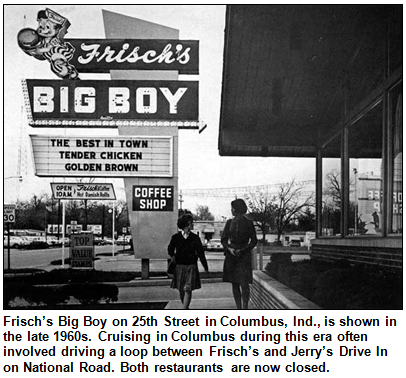 Among all of the hang-outs that thrived across the country during the "cruising" craze of the 1950s, did any city have a drive-in more beloved than the Tee Pee Restaurant in Indianapolis?
Among all of the hang-outs that thrived across the country during the "cruising" craze of the 1950s, did any city have a drive-in more beloved than the Tee Pee Restaurant in Indianapolis?
Actually, the Hoosier capital spawned two Tee Pees. The first, which opened in the 1930s and initially was called the Wigwam, enjoyed a high-visibility site next to the Indiana State Fairgrounds off busy Fall Creek Parkway. Years later, a second Tee Pee opened on the Southside.
To explore the distinctive-looking Tee Pees and other Hoosier drive-ins, both those that are bygone and the smattering that remain, Nelson will be joined in studio by two guests with special connections to them:
- Public historian and preservationist Glory-June Greiff spearheaded a much-publicized (but, alas, unsuccessful) crusade to save the Tee Pee from the wrecking ball in the 1980s. Its site is now overflow parking for the fairgrounds.
- Retired WRTV-Channel 6 cameraman Dick Baldwin was one of the Tee Pee's most loyal customers, beginning in the 1950s. As the only news photographer at Channel 6 (then known as WFBM) when he started in 1957, Dick says he preferred to patronize drive-ins because he could zip away quickly if his ever-present police scanner stared crackling with news about an emergency.
Glory-June, Dick and Nelson won't confine their drive-in focus to the Tee Pees. Nelson will share insights about Knobby's Restaurants in Indy, popular drive-ins patronized by his family during the 1960s and '70s.
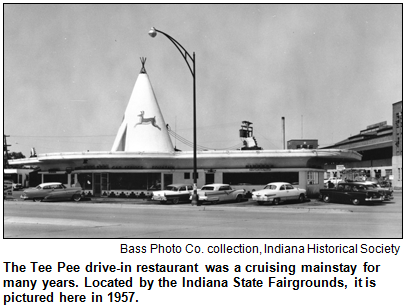 Glory, who grew up in northern Indiana, will dish about Bonnie Doon Drive-Ins of South Bend and Mishawaka. Some Bonnie Doon locations - the source of Glory's fondness for choco-mint sodas - continue to thrive today.
Glory, who grew up in northern Indiana, will dish about Bonnie Doon Drive-Ins of South Bend and Mishawaka. Some Bonnie Doon locations - the source of Glory's fondness for choco-mint sodas - continue to thrive today.
Although the Tee Pee was his fave, Dick also patronized the bygone Pole, a popular drive-in at Lafayette Road and West 16th Street in Indy.
Nor will we forget the Ron-D-Vu near the Butler University campus, the North Pole at Illinois and 56th streets, and Al Green's Famous Food Drive-In on the eastside.
Then there's Don Hall's Hollywood Drive-In in Fort Wayne, which also survives today. Its promotions assure customers "the fabulous '50s will live on forever" there.
Also going strong amid so many drive-in casualties are the Mug n Bun on the westside of Indy and The Suds Drive-In in Greenwood, which opened as the Dog n' Suds in 1957.
According to The American Drive-In (Motorbooks International, 1994) by Michael Witzel, many of the beloved restaurants - once settings for "some of the most spontaneously enjoyable diversions" for young people and families alike - suffered an "astonishingly sudden fall from grace" because of the booming popularity of fast-food chains, particularly when drive-through windows became common.
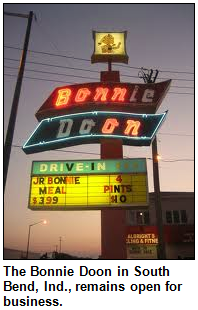 "Waiting for a carhop to serve a meal and remove the dishes became a luxury of another era," Witzel writes.
"Waiting for a carhop to serve a meal and remove the dishes became a luxury of another era," Witzel writes.
Of course, for many enthusiasts of drive-ins, the food almost was beside the point - no matter how scrumptious the burgers, French fries, milkshakes and tenderloins.
Many drive-ins became ideal for cruising, including the Tee Pee, which was nearly surrounded by pavement because of the nearby fairgrounds and East 38th Street. Not only were high school and college students drawn to the landmark for decades, demand for a southside location eventually resulted in the opening of the second Tee Pee on Madison Avenue.
Although the Tee Pees were known for fare such as Big Chief burgers, Dick Baldwin, a member of Tech High School's class of '54, says many folks have forgotten that "wonderful" prawns and a special salad dressing also were served.
The small, locally owned Knobby's chain served milkshakes that Nelson recalls as delicious. The longest-lasting Knobby's, located at 52nd and Keystone Avenue, had long since ceased being a drive-in when it closed. 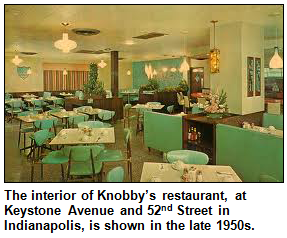 That was in early 2002, by which point Knobby's had been serving up "food and memories" (as The Indianapolis Recorder once put it) for more than 50 years, having opened in 1951. Tune in to our show to hear Nelson explain the intriguing origin of the Knobby's name.
That was in early 2002, by which point Knobby's had been serving up "food and memories" (as The Indianapolis Recorder once put it) for more than 50 years, having opened in 1951. Tune in to our show to hear Nelson explain the intriguing origin of the Knobby's name.
And we will have Glory-June share memories about her crusade to save the beloved Tee Pee. The focus of TV news coverage and other media accounts during her campaign, Glory practically stood in front of bulldozers to try to stop the demolition.
She was a studio guest on Hoosier History Live! last year for a show about the history of state parks in connection with her book People, Parks and Perceptions (Trafford Publishing, 2010). Glory also is the author of Remembrance, Faith and Fancy (Indiana Historical Society Press, 2005), a look at outdoor sculpture across the state.
This time around, park yourself at the radio and tune in as we savor the culture of cruising and the drive-ins that served as its epicenter.
History Mystery
The Ron-D-Vu, a drive-in restaurant near the Butler University campus, was popular during the 1950s. 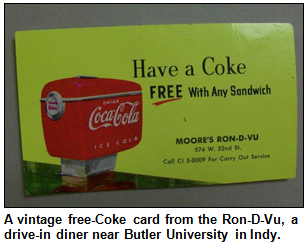 It also is mentioned frequently in a novel, a national bestseller by an Indianapolis writer who graduated from Shortridge High School. The novel was published in 1970 and was made into a movie more than 25 years after that, but the setting is the 1950s.
It also is mentioned frequently in a novel, a national bestseller by an Indianapolis writer who graduated from Shortridge High School. The novel was published in 1970 and was made into a movie more than 25 years after that, but the setting is the 1950s.
Question: What is the name of the best-selling novel that includes frequent references to the Ron-D-Vu?
To win the prize, you must call in with the correct answer during the live show. Please do not call if you have won a prize from any WICR show during the last two months. The call-in number is (317) 788-3314, and please do not call until you hear Nelson pose the question on the air.
The prize is an overnight stay at the Hilton Indianapolis North, courtesy of the ICVA, as well as a pair of tickets to a mid-December Victorian Tea at the Morris- Butler House, courtesy of Indiana Landmarks.
Roadtrip: Gene Stratton-Porter cabin near Rome City
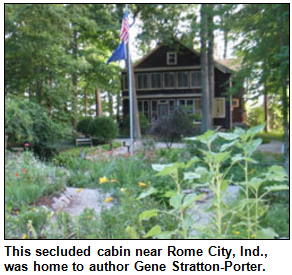 Our Roadtripper, Chris Gahl of the ICVA, suggests we take the Roadtrip to the Cabin in the Wildflower Woods near Rome City, Ind. Lesser known than her Limberlost cabin near Geneva,
the Rome City cabin was author Gene Stratton-Porter's second adult home. It was built in 1913 beside a vast, undeveloped forest that provided inspiration for her writing, nature studies and photography.
Our Roadtripper, Chris Gahl of the ICVA, suggests we take the Roadtrip to the Cabin in the Wildflower Woods near Rome City, Ind. Lesser known than her Limberlost cabin near Geneva,
the Rome City cabin was author Gene Stratton-Porter's second adult home. It was built in 1913 beside a vast, undeveloped forest that provided inspiration for her writing, nature studies and photography.
Furnishings in the home are arranged and maintained to reflect, as authentically as possible, the author's lifestyle, and the graves of both Gene Stratton-Porter and her daughter Jeannette are located here.
Both of the author's homes are state historic sites.
Your Hoosier History Live! team,
Nelson Price, host and creative director
Molly Head, producer, (317) 927-9101
Chris Gahl, Roadtripper
Richard Sullivan, webmaster and tech director
Pam Fraizer, graphic designer
Garry Chilluffo, creative consultant
Michele Goodrich, Jed Duvall, grant consultants
www.hoosierhistorylive.org


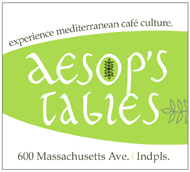


Please tell our sponsors that you appreciate their support: Aesop's Tables, Indiana Historical Society, Lucas Oil, Sexton Companies and Story Inn.
 Acknowledgments to Print Resources, Indianapolis Marion County Public Library, Monomedia, Indiana Humanities, Indianapolis Convention & Visitors Association, WICR-FM, Fraizer Designs, Heritage Photo and Research Services, Derrick Lowhorn, Samantha Stratton and many other individuals and organizations. We are an independently produced program and are self-supporting through organizational sponsorships, grants and through individual tax-deductible contributions through the Indiana Humanities Council. Visit our website to learn how you can support us financially.
Acknowledgments to Print Resources, Indianapolis Marion County Public Library, Monomedia, Indiana Humanities, Indianapolis Convention & Visitors Association, WICR-FM, Fraizer Designs, Heritage Photo and Research Services, Derrick Lowhorn, Samantha Stratton and many other individuals and organizations. We are an independently produced program and are self-supporting through organizational sponsorships, grants and through individual tax-deductible contributions through the Indiana Humanities Council. Visit our website to learn how you can support us financially.
A weekly thing
Hoosier History Live! at Irvington Library
The kickoff Irvington Library Hoosier History Live Radio Club of the Air was hosted last week by the Irvington Library's public services associate, Mike Hylton. The listening and discussion group will continue to meet on a weekly basis in the Story Theater of the Irvington Library, 5625 E. Washington St., at 11:30 a.m. on Saturdays.
Dec. 3 show - Live from the Holiday Author Fair
Hoosiers behind the scenes, girls hoops stars, Indiana poets and dirt roads
 For the fourth year, Hoosier History Live! will broadcast from a remote (non-studio) location: The Eugene and Marilyn Glick Indiana History Center, which will bustle and abound with captivating interviewees, as about 70 authors with Indiana connections gather for the 9th Annual Holiday Author Fair.
For the fourth year, Hoosier History Live! will broadcast from a remote (non-studio) location: The Eugene and Marilyn Glick Indiana History Center, which will bustle and abound with captivating interviewees, as about 70 authors with Indiana connections gather for the 9th Annual Holiday Author Fair.
Nelson will be doing round-robin chats with a range of fellow authors. Our show will feature:
- Gayle Johnson, the author of The Making of Hoosiers, a book of behind-the-scenes stories about the film released in 1986 that's been heralded as the best sports movie ever made. Gayle, an Indianapolis-based editor and writer, will share insights about how the Indiana towns that served as filming sites - including Knightstown, Nineveh and New Richmond - have been changed as a result. During the Holiday Author Fair, she also will offer a presentation for the public about the making of Hoosiers as part of the 25th anniversary of its release; Gayle will be speaking along with the movie's screenwriter Angelo Pizzo, who was a studio guest on our show this past summer.
- Dick Denny, a former sportswriter for The Indianapolis News who has written a book that profiles 30 of the greatest stars of girls high school basketball in Indiana. His new book, We Live the Game (Blue River Press/Cardinal Publishing Group), features interviews with former Perry Meridian High School great Katie Douglas, who currently plays with the Indiana Fever.
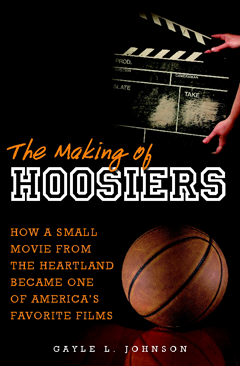 Others include former Seeger High School star Stephanie White, as well as Jennifer Jacoby, who apparently used the movie Hoosiers as an inspirational tool when she was an outstanding player at Rossville High School. (Jennifer currently is the athletic director at Knightstown High School.)
Others include former Seeger High School star Stephanie White, as well as Jennifer Jacoby, who apparently used the movie Hoosiers as an inspirational tool when she was an outstanding player at Rossville High School. (Jennifer currently is the athletic director at Knightstown High School.)
- Jenny Kander, co-editor of And Know This Place: Poetry of Indiana (Indiana Historical Society Press), an anthology featuring great poets who have had Hoosier connections. Jenny, who is based in Bloomington, has included poetry from such writers as James Whitcomb Riley, Jessamyn West and Etheridge Knight. Jenny and her co-editor, C.E. Greer, write that they have selected poems that cover the spectrum of the state "in settings from city streets to wilderness tracks (and) ... from Goshen in the north to Floyd's Knobs by the Ohio River."
- And Connie Nordhielm Woodridge, the author of a new book for children titled Just Fine the Way They Are: From Dirt Roads to Rail Roads to Interstates(Calkins Creek/Boyds Mills Press). Connie, who lives in Richmond, explains for her young readers how people have reacted with each change in our land transportation system's evolution, beginning with the dirt roads of the early 1800s. Characters include the keeper of a tavern who objects to the creation of the Old National Road, as well as owners of railroads who express concerns about the first Model-T in 1908.
© 2011 Hoosier History Live! All rights reserved.